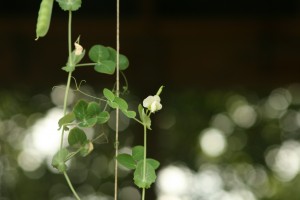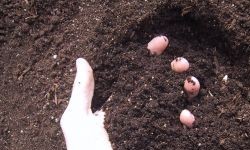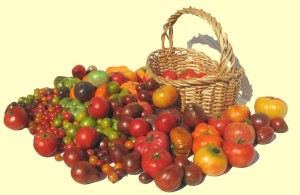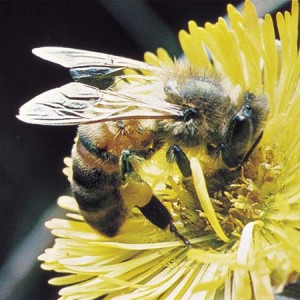
 Brown thumbs can turn brown, I promise. The trick to vegetable gardening is similar to any sort of gardening or landscaping – know your environment. I’ve learned an immense amount about gardening since moving to the coastal plain from the more fertile piedmont region of NC. Growing vegetables in the piedmont was as easy as throwing a seed in the pile of dirt behind the house. In sandy coastal regions, not so. Here’s some of my lessons, which I think can be taken and adapted just about anywhere…
Brown thumbs can turn brown, I promise. The trick to vegetable gardening is similar to any sort of gardening or landscaping – know your environment. I’ve learned an immense amount about gardening since moving to the coastal plain from the more fertile piedmont region of NC. Growing vegetables in the piedmont was as easy as throwing a seed in the pile of dirt behind the house. In sandy coastal regions, not so. Here’s some of my lessons, which I think can be taken and adapted just about anywhere…
The Soil
Hands down, the most important part of your garden is the soil. There are a couple different aspects to think about, but at a very basic level the most important concerns are how fast it drains and how many nutrients it contains. Sandy soil like mine will dry out half way through a hot summer day because it has no means of holding water in the soil matrix. On the flipside, some areas of Virginia and North Carolina have a hard clay layer hiding a few inches below the surface that offer little drainage after rain. Either situation can be amended by adding a little of the other – a three-way mix of sand, peat, and organic matter (top soil) is usually a safe bet.

Nutrient-wise, many soils are historically well-endowed. However, housing development and/or years of growing nutrient-hungry vegetables in the same place may leave your garden spot depauperate. There are several ways to solve this problem, only one of which can happen while plants are in the ground – direct amendment by either organic or synthetic fertilzer. These fertilizers will be labeled with N-P-K (nitrogen, phosphorus, potassium) content and offer only the most basic vitamin mix for your green and leafies. A better bet is to more completely amend the soil prior to planting, either by stirring in compost or by planting cover crops over the winter.
Personally, I learned the importance of soil quality the hard way after several years of stirring compost into sand, attempting to make the right mix. What nutrients I did add likely ran straight into the groundwater during the next big summer storm instead of feeding my hungry plants. My new strategy is to plant in a raised bed filled with garden soil from the local hardware store.
The Plants
Modern grocery store culture might at first make you think that all tomatoes are red and perfectly round, green beans are green, and carrots are orange. But if you’ve ever visited a farmer’s market and enjoyed heirloom varieties, you might know better. The beauty of heirloom varieties goes far beyond extra colors and shapes, however. These varieties, sometimes bred by a family living on the same plot of land for hundreds of years, are perfectly tailored to the microclimate of a specific locality. For my region, that means that there are traditional corn, bean, tomato, and rice varietals that can handle the heat and drought of the summers and can sometimes deal with the nutrient-poor, sandy soils. Plus, they are adapted to garden life, not industrial farm life.

So where do these magic plants come from? There are companies such as Seed Savers Exchange dedicated to maintaining heirloom varieties, both maintaining existing strains and collecting new varieties from family farms. They offer catalogs every year – and believe me, there’s nothing more exciting on a cold winter day than flipping through the colorful pages picking out what you’ll plant later that spring. The more local source is your local
There are other benefits to supporting heirlooms beside having plants well-adapted to your backyard. Many of these plants (and animals) are at risk of being lost forever, so support for them by allowing them in your garden space helps the preservation cause. These breeds supply the genetic diversity in our crops should something happen to the varieties currently on the mega-farms. Your garden could be part of that mission. And because they’ve been grown by traditional methods, you can always save your seeds and plant them again next year.
The birds and the bees

Unlike houseplants, which can subsist off of just water and sunlight, growing fruits and vegetables requires most of your plants to have sex. That requires ensuring you have male and female plants for species that need it, at least two of each type of plant (self-pollination is rare), and the birds and the bees, literally. Yep, it’s where the expression comes from – birds and especially bees are often required to carry the pollen (sperm) of one plant to the awaiting female flowers on another plant. And with the recent rise of colony collapse disorder, bees are sometimes hard to come by. So hard, in fact, that professional farms have to truck their bees in.
What this means for the backyard gardener is that there should at all times be flowers around to attract those lovely neighborhood bees. Of course, if you’re interested, you could always start beekeeping (I hear it’s quite rewarding). There are certain varieties that are known to bring them in, such as bee balm, but any showy flower should work. Plus, they’re a beautiful, colorful addition to your vegetable collection.
Ready, go plan
Finally, plan your garden – plant different varieties of tomato and squash so that you aren’t buried by a pile of ripe ones all at once. Also, if your garden is going to substantially supplement your diet, consider growing a balanced diet – get some mushrooms, eggplant, sunflowers, beans, or peanuts in there for protein. Beans and peanuts also are legumes, meaning that they bring nitrogen into the soil, feeding the garden as well as you. There are many ways to get great food from your backyard, but Square Foot Gardening has caught my eye recently. The idea behind it is to carefully time your plantings and make use of symbiotic plantings to make the most of your space.
Have fun! And remember, every county has a university extension office if you have questions specific to your area! They even offer classes, well worth taking advantage of.